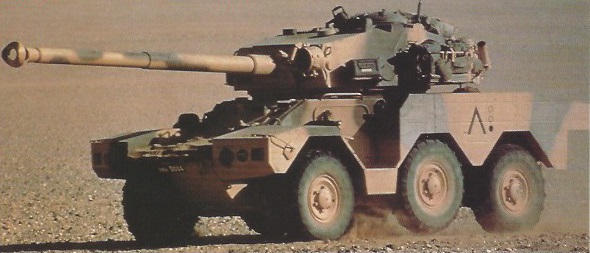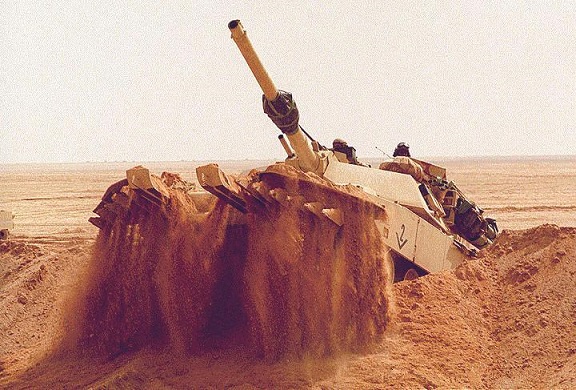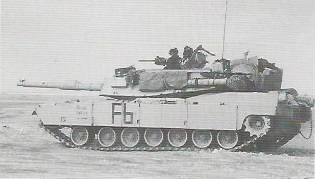This is a collection of photos taken during Desert Shield and later Storm (August 1990 to March 1991). Most of these photos are of the lesser known units of the XVIII Airborne Corps which fought in the western Iraqi desert and north of Kuwait. Also included are some Iraqi armor which were encountered, a controversial engagement and movie Abrams.
On 2 August 1990, the military forces of Iraq invaded Kuwait. The first armor unit that was airlifted to Saudi Arabia during Desert Shield in August of 1990 was the 3rd battalion, 73rd Armored Regiment, US 82nd Airborne Division equipped with 40 M551A1 Sheridans. Although the Sheridan was armed with a 152mm gun, if the Iraqis decided to attack Saudi Arabia at that time those Sheridans would not stood a chance against the large Iraqi armor force.
With the green camouflage smeared over with sand, this Sheridan is training in the desert.

This is a Panhard ERC 90 Sagaie from the reconnaissance squadron of the French 1stRégiment de Hussards Parachutistes (1st RHP). The HMMWV in the background probably belonged to the US 82nd Airborne Division.

The 1st RHP had 12 ERC 90s with the French 6th Light Armored Division AKA Division Daguet. The division was named after the French operation during Desert Shield/Storm. The French units operated in the western desert to the west of the US 24th Infantry Division.


Armor units of the 24th Mechanized Infantry Division arrived in Saudi Arabia in late August-early September 1990. The division was originally equipped with the M1 and trained in them with the US Airborne divisions for several months. Due to the threat of Iraqi chemical weapon attacks and the M1A1 had NBC protection which the M1 did not, all frontline M1s were replaced with M1A1s before the ground war started.
This is a 24th ID M1 training in the desert.

The 3rd Armored Cavalry Regiment (3rd ACR) arrived in Saudi Arabia in September 1990 and was assigned to the XVIII Airborne Corps and trained with the 82nd Airborne, 101st Airborne, and the 24th Infantry Divisions. This was the first unit equipped with M1A1s sent to Saudi Arabia and their M1A1s arrived still painted in green camouflage. It was sometime later when they were repainted in desert colors.


In early January 1991, 40 AMX-30s of the 4th Dragoons were deployed to Saudi Arabia. These AMX-30B2s were modified with sand filters, side armor plates and smoke launchers. During the ground war, they fought beside the 2nd brigade of the US 82nd Airborne Division. On two occasions, they attacked and destroyed Iraqi T-55s and T-59s.

Perhaps the strangest armor arrangement used by the French is this old AMX-30 fitted with a Soviet-built KMT (koleinyi minnyi tral, rut mine sweep) mine roller which came from the former East German National Peoples Army (German: Nationale Volksarmee – NVA) and was donated to the French by the German government.

MPs manned a check point along a convoy route in January 1991 somewhere in the Saudi desert. I still have the Pink Floyd The Wall album on CD and I like being “Comfortably Numb”.


Due to the threat that the Iraqis might employ chemical and biological weapons, the US Army employed the “Fox” Nuclear, Chemical, Biological, Reconnaissance System (NCBRS)vehicle which was based on the German designed “Fuch” NBC variant. Due to limited numbers in US service, the Germans supplied 60 of these vehicles to the US Army and these belonged to the US 3rd Infantry Division, VII Corps chemical company traveling west along a highway.
Does this mean its us against them?

This is a US Army Czech built Tatra T815 8×8 truck towing a semi-trailer carrying a M109A1 155mm SP. The NVA supplied 62 Tatra T815 trucks to US units for use in Desert Shield/Storm.

This M1A1 equipped with a Tank Width Mine Plow (TWMP) is penetrating a sand berm. Note the canvas cover around the gun barrel fume extractor.

3rd ACR M1A1 G2 (G Troop, 2nd Platoon) equipped with a TWMP.

3rd ACR M1A1 F6 (F Troop, 6th Platoon)

22 January 1991:
Blue Scout Platoon, I Troop, 3rd ACR became the first US ground unit to see action in the conflict. While on a recon patrol about 100 km (62.1 miles) west of the regiment’s assembly area, the platoon encountered a Saudi Arabian border guard who requested assistance because his position had came under attack from Iraqi soldiers across the Saudi/Iraqi berm. The platoon conducted reconnaissance by fire onto the Iraqi positions and received return fire from the Iraqis then the platoon breached the berm. After two of their own casualties, inflicting casualties on the Iraqis, and took several Iraqis as POW, the platoon withdrew.
3rd ACR M1A1 I2 seen later during the ground war.

This 24th Infantry Division M998 HMMWV is mired in the sand in the Shamya desert. The large inverted chevron was the Coalition identification marking applied to all invasion vehicles just before the ground war began on 24 February 1991.

This Fox NCBRS vehicle of the US 3rd Infantry Division was attached to the French units during Operation Daguet. Note the Coalition chevron.

This M998 HMMWV is towing a M167 Vulcan Air Defense System (VADS) trailer. The M167 mounted a General Dynamics 20mm M61 Vulcan rotary cannon and carried its own radar unit and ammunition.

The M113A1 was still in US service and used in many secondary roles. This is a 24th ID Ambulance belongs to a medical unit. Note the large Coalition chevron marking.

26 February 1991 – 24th ID video: C-SPAN News clip
Battle for Jalibah Airfield
27 February 1991:
2nd Brigade, 24th ID successfully attacked and captured the heavily defended Jalibah Southeast Air Base located 80 miles (128.7 km) west of Basra. Prior to the attack, recon indicated 1,000+ dug-in Iraqi soldiers, AA guns, and about 20 tanks. At 0600 hours, after an artillery barrage, the 2nd Brigade attacked along Highway 8 and secured the airfield after 4 hours of fighting. However during the attack, M1A1s of C Company, 3rd Battalion, 69th Armor Regiment (3-69) mistakenly fired upon and hit three M2 Bradleys of C Company, 3rd Battalion, 15th Infantry Regiment. They fired between 8-16 rounds at what they identified as Iraqi T-72s.
This was one of the captured T-55s at the airfield.

28 February 1991:
At 0330 hours, a Presidential Cease Fire was ordered which to take affect at 0800 hrs. Despite the Cease Fire, the 3rd ACR and the 24th ID still continued to encountered action in their sector.
1 March 1991:
At 1047 hours, the 3rd ACR reported receiving tank fire and returned fire in self defense. Five T-55s and five ZSU-23-4s were destroyed in this engagement.
3rd ACR M1A1 named “ORCINUS ORCA” near Basra. It is the scientific name for the killer whale. Note the unit codes were painted out.

The 24th ID was on Oahu at Schofield Barracks during the Pearl Harbor attack and was named the “Victory” Division during WWII. This M1A1 with “V”s on the turret front armor was attached to the 24th ID. Note that the lower front hull was coated with something probably sand or paste to hide the unit markings.

Battle at Rumaila
2 March 1991:
The battle at Rumaila (AKA the Battle of the Causeway or the Battle of the Junkyard) was a controversial engagement that occurred two days after the cease fire around the Rumaila oilfields in the Euphrates Valley in southern Iraq. This was the last tank vs. tank engagement of Desert Storm and probably the last large armor engagement of the 20th century. The 24th ID was advancing east toward Basra with the 3rd ACR covering its southern flank.
Task Force TUSKERS of the 24th ID was a task-organized tank battalion from the 4-64 Armor (4th Battalion, 64th Armor Regiment). It consisted of two M1A1 companies, two M2 Bradley infantry companies, an engineer company and a HQ company. The 1st Brigade was two infantry battalions defending forward and Task Force TUSKERS was in reserve behind them. Meanwhile the remains of the Republican Guard was bottled up in the Basra pocket and was probing the US lines along Highway 8 to find an escape route back to Baghdad. The scout elements of the 24th ID had reported vehicles with their lights on moving north towards the Euphrates River.
At 0700 hours, an armored convoy of T-72s and BMPs from the Iraqi 1st Hammurabi Armored Division (an elite formation of the Iraqi Republican Guard) ran into the scouts of 2nd Battalion, 7th Infantry and opened fire. Some sources states that the Iraqis did not fired the first shots and not all the Iraqi units were even informed that a cease fire was in effect. After a brief exchange of shots, the scouts overran an Iraqi dismounted RPG team but then reached their limit of advance. The 2-7 Infantry moved its companies forward and return fire. The rules of the US declared cease-fire allowed US forces to return fire when fired upon so the 24th ID launched a counterattack by the 1st Brigade. While the brigade prepared to attack, the 1st Bn., 24th Aviation Regiment (AH-64 Apache attack helicopter squadron) and artillery would attack the Iraqi the convoy first and then the TUSKERS would move in to finish the job.
This 2-7 Infantry Bradley is seen on Highway 8 west of Basra.
It appears to have a couple of highway signs added for additional armor protection.

At 0830 hours, the Apache helicopters began their attack while the artillery fired scatterable munitions onto the causeway creating instant minefields slowing the Iraqis’ movement. Bumper to bumper, the Iraqis column was jammed up for miles. The Apaches fired 107 Hellfire missiles and many rounds of 30mm shells. After expending their ammo and low on fuel, the helicopters left the area leaving over 120 burning vehicles.
At 1015 hours, the TUSKERS moved to an attack position just behind 2-7 Infantry. The battalion was in a box formation with the two tank company teams on the front corners of the box and two mechanized infantry teams on the rear corners. Tank teams ANVIL and COBRA each consisted of 10 M1A1s and 4 M2 Bradleys. Mechanized teams ALL BEEF and CHARLIE MIKE each consisted of a mix of 10 M2 Bradleys and 4 M1A1s.
At 1045 hours, the order came and the TUSKERS went into action. On the front left and right corners of the wide attack formation were COBRA and ANVIL tank teams. As the task force advanced toward the Iraqis, the open, flat desert became a marshy oil field with pipelines when they veered north towards the causeway. The vehicles were forced to line up in staggered columns on the roads. In the causeway area, the road system was shaped like a diamond with railroad tracks (running east-west) at the south end and the causeway bridge across the Euphrates River at the north end. A single intersection at the RR crossing created a chokepoint which branched into three roads leading north to the causeway bridge and the companies split onto these roads. COBRA and CHARLIE MIKE took the left branch (west) of the diamond while ANVIL and ALL BEEF took the right branch (east). After passing the chokepoint, billows of smoke was seen just over the horizon proving that the Apaches and artillery had done their job on the Iraqis.
This is the Rumaila oilfields today and the red dot was the chokepoint location.
Basra (north of Kuwait) is to the east (right) of the Rumaila oilfields.

The ANVIL column was moving forward on a road raised about four feet above the surrounding mud flats and encountered several Iraqi trucks and a BMP stopped at odd angles on the road in front of them. The lead tank platoon opened fire on the derelict vehicles. The BMP burst into flames and a truck that was hit exploded. After the 2nd Platoon passed the burning BMP, it was realized a truck was missed. The last tank of the platoon was ordered to destroy the unscathed truck. As MG fire hit the truck, it exploded and immediately set off a secondary explosion in a truck next to another platoon tank. Tank A-22 caught fire when burning debris fell through the open hatches and the internal fire extinguishers failed to put out the flames. The tank commander ordered the crew to abandon the tank and the stunned/burnt crew took cover next to the road as ammunition on the truck continued to cook off. The rest of the platoon tried to putout the flames using hand-held fire extinguishers. The trucks were left for the engineers to clear and A-22 was ordered destroyed once it was realized it cannot be saved. Tank A-31 executed the grim task by firing two sabot rounds through the rear of the turret completing A-22’s destruction. ANVIL and COBRA teams systematically destroyed the Iraqi tanks and APCs as they advanced north. All trucks were left to be blown up by the engineers after the area was secured.

By 1500 hours, the companies reached the north end of the peninsula and the beginning of the causeway and could not proceed any farther. The companies then began rounding up POWs and tended to the WIAs. The 24th ID destroyed about 30 Iraqi tanks, 33 artillery pieces, 56 other armored vehicles, and 486 trucks including about 200 Iraqi soldiers KIA and 89 POWs. The 24th ID only had one WIA soldier and one tank destroyed by fire. The Iraqi surrender talks were held the next day at Safwan.

A pair of 2nd Battalion, 4th Cavalry Bradleys 30 km (18.6 miles) west of Basra.
Note the camouflage pattern with bands of brown.
The 64th Armor Regiment’s insignia is a black African elephant with two white tusks, symbolic of the unit’s history as an all African American unit with two white officers. The regiment is descended from the 758th Tank Battalion (African-American) attached to the US 92nd Infantry Division “Buffalo Soldiers” which fought in the Italy during WWII. After the war, the 758th was re-designated as the 64th Tank Battalion and was attached to the US 3rd Infantry Division during the Korean War.
4-64 Armor Regiment Markings:
The direction of the chevron indicated the company and the number of small squares indicated the platoon.

Troopers displays a US flag in front of a T-55M at the Rumaila oilfields. Note the T-55M is equipped with KMT-6 mine clearance plows.

Another abandoned T-55 at the Rumaila oilfields. Note its reflection in the black seepage on the ground. Oil that is, black gold, Texas tea.

An abandoned Republican Guard T-72 on the Baghdad-Basra highway. The only marking is the green disc on the turret rear. Note the auxiliary fuel tanks on the rear hull and the gun barrel muzzle is covered.

A ZSU-23-4M Shilka abandoned on a road side near Basra. This is the latest variant of the Shilka indicated by the three access doors on the left side of the hull.

A captured Iraqi BTR-60PU with “Hawk Eye” telescopic antenna. It appears the photographer has caught the soldier in mid-air jumping to the ground. To me, the antenna makes it look like an unicorn.

M551A1 Sheridans and crews of the 3rd battalion, 73rd Armored Regiment are waiting to be transported back to the USA after being in the desert for six months . Not able to find information on the tactical markings for this unit.

The graffiti on this 24th ID truck displays that the attitude of many US soldiers has changed over time.

ABRAM TANKS IN MOVIES
“Courage Under Fire” 1996, Denzel Washington, Meg Ryan, Lou Diamond Phillips, and Matt Damon.

This scene is during the first 9 minutes of the movie.
The US Army refused to provide any Abrams tanks to the movie company probably due to the fratricide and cover-up plots but more likely due to security reasons. Twelve Centurions were purchased and made up with plywood and fiberglass to become mock up Abrams for the movie.
For more info see link: THE LOST CENTURIONS
“Jarhead” 2005, Jake Gyllenhaal, Jamie Foxx, Peter Sarsgaard and Chris Cooper.

This is a Vickers-Armstrong FV4201 Chieftain made up to be a M1A1 by Armytrucks, Inc. It is only seen in one short scene in the movie.
For more info see link: ARMYTRUCKS INC
Note the bulged fume exactor and the early T-156 tracks on this M1A1. Would you call this additional armor or camouflage?


you got some of the battle at rumalia all wrong not sure were you got your information but not right
LikeLike
Sir –
My research came from several articles on the internet and a couple of books.
Please tell me what parts are incorrect and what actually happened.
I am very interested and want to post accurate information.
Thank you
LikeLike
I really like it when people get together and share ideas.
Great website, stick with it!
LikeLike
A lot of thanks for your own labor on this blog. My niece really loves managing investigations and it’s really simple to grasp why. Almost all learn all regarding the compelling means you produce very useful steps on this blog and even invigorate response from people on that article plus our own princess has always been starting to learn a whole lot. Enjoy the rest of the new year. You’re the one doing a splendid job.
LikeLike
The markings on the M551 Sheridans that were were unable to find are of B Company, 3rd platoon and the platoon leader Sheridan of 2nd platoon. I was the B Company Commander during operations desert shield and storm. I originally went over as the battalion maintenance officer and then took command shortly after I arrived. My 3rd platoon leader, 1st Lieutenant Sanders was the one who destroyed the Iraqi gun with a missile. He told me that’s what he had in the tube. When we started to receive fire. Lots of memories! Thank you.
LikeLike
My unit (3-2 ADA) received some of those Tatras.
LikeLike